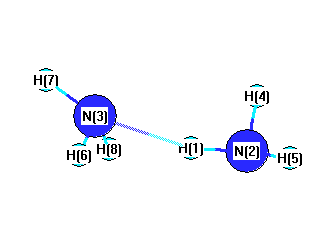Vibrational Frequencies calculated at B3LYP/3-21G
| Mode Number |
Symmetry |
Frequency
(cm-1) |
Scaled Frequency
(cm-1) |
IR Intensities
(km mol-1) |
Raman Act
(Å4/u) |
Dep P |
Dep U |
|---|
| 1 |
Ag |
3502 |
3379 |
0.00 |
|
|
|
| 2 |
Ag |
3339 |
3222 |
0.00 |
|
|
|
| 3 |
Ag |
1749 |
1688 |
0.00 |
|
|
|
| 4 |
Ag |
1016 |
981 |
0.00 |
|
|
|
| 5 |
Ag |
609 |
588 |
0.00 |
|
|
|
| 6 |
Ag |
233 |
224 |
0.00 |
|
|
|
| 7 |
Au |
3531 |
3407 |
2.21 |
|
|
|
| 8 |
Au |
1785 |
1722 |
30.02 |
|
|
|
| 9 |
Au |
364 |
351 |
90.16 |
|
|
|
| 10 |
Au |
170 |
164 |
42.53 |
|
|
|
| 11 |
Bg |
3530 |
3406 |
0.00 |
|
|
|
| 12 |
Bg |
1770 |
1708 |
0.00 |
|
|
|
| 13 |
Bg |
247 |
238 |
0.00 |
|
|
|
| 14 |
Bu |
3505 |
3382 |
50.95 |
|
|
|
| 15 |
Bu |
3357 |
3239 |
104.28 |
|
|
|
| 16 |
Bu |
1716 |
1656 |
14.85 |
|
|
|
| 17 |
Bu |
851 |
821 |
581.58 |
|
|
|
| 18 |
Bu |
192 |
185 |
417.38 |
|
|
|
Unscaled Zero Point Vibrational Energy (zpe) 15732.7 cm
-1
Scaled (by 0.9649) Zero Point Vibrational Energy (zpe) 15180.5 cm
-1
See section
III.C.1 List or set vibrational scaling factors
to change the scale factors used here.
See section
III.C.2
Calculate a vibrational scaling factor for a given set of molecules
to determine the least squares best scaling factor.
Charges, Dipole, Quadrupole and Polarizability
Charges from optimized geometry at B3LYP/3-21G
Charges (e)
| Number |
Element |
Mulliken |
CHELPG |
AIM |
ESP |
| 1 |
H |
0.288 |
|
|
|
| 2 |
N |
-0.799 |
|
|
|
| 3 |
N |
-0.799 |
|
|
|
| 4 |
H |
0.255 |
|
|
|
| 5 |
H |
0.255 |
|
|
|
| 6 |
H |
0.288 |
|
|
|
| 7 |
H |
0.255 |
|
|
|
| 8 |
H |
0.255 |
|
|
|
Electric dipole moments
Electric dipole components in Debye
(What's a Debye? See section
VII.A.3)
| |
x |
y |
z |
Total |
| |
0.000 |
0.000 |
0.000 |
0.000 |
| CHELPG |
|
|
|
|
| AIM |
|
|
|
|
| ESP |
|
|
|
|
Electric Quadrupole moment
Quadrupole components in D Å
Polarizabilities
Components of the polarizability tensor.
Units are
Å
3 (Angstrom cubed)
Change units.
| |
x |
y |
z |
| x |
0.000 |
0.000 |
0.000 |
| y |
0.000 |
0.000 |
0.000 |
| z |
0.000 |
0.000 |
0.000 |
<r2> (average value of r
2) Å
2
| <r2> |
57.946 |
| (<r2>)1/2 |
7.612 |
